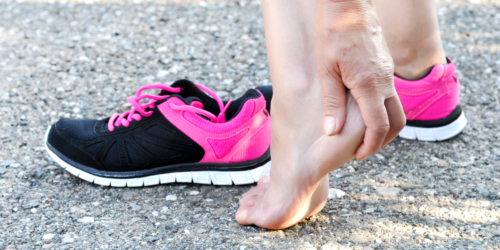
If the shoe fits, wear it.
- Whether you plan to hit the winter trails, ski slopes, or take a walk around the neighborhood, select your shoes with comfort and safety in mind. Protect your feet from blisters, calluses and injury by selecting well-fitting shoes.
- Wear shoes that have a bit of wiggle room in the toe-box. Cramping your toes in a small confined toe-box can cause bacteria and fungus to grow from the natural moisture and sweat your feet produce.
- Wearing appropriate footwear is key. You want to look for shoes that have padding and are still roomy enough to not cut off circulation. Wearing shoes made from breathable fabrics can help control moisture.

Warm dry feet, warm heart.
- Moisture wicking socks are excellent at keeping your feet warm and dry. When your feet sweat, wet socks allow the cold to sleep in. This makes you extra cold, as well as promoting bacteria and fungal growth. You can tell that your feet are sweaty when they appear extra pale or your toes “wrinkle”. If you notice that your feet feel itchy because they are wet, soaking your feet in a warm water bath with vinegar (white or apple cider both work) for 10 minutes will help. Remember to dry your feet completely when you take your socks off and again after your bath or shower.
- A nice way to restore heat into your feet is to apply foot cream in a circular motion and massage from your heels to your toes.
- Suffer from cracked scaly feet? A home remedy using a mixture of olive oil and sea salt replenishes moisture while gently exfoliating away layers of superficial dead skin.
- It is important that your feet are well hydrated without being wet. A good rule of thumb for good foot hydration: creams are better than lotions or petroleum products because creams allow your feet to “breathe”.

Watch for ice and snow.
- Winter wonderlands can be beautiful but also dangerous. Use caution when traveling outdoors and watch for ice and snow patches along your trail.
- Remove wet shoes and socks as soon as possible when you are inside. With snow sitting on the ground, it’s hard to keep your feet completely dry. By removing your wet shoes and socks as soon as you can helps prevent bacterial and fungal infections.
- Before putting your shoes back on, check to make sure they are completely dry.
- Wearing inappropriate shoes can cause frostbite. Please wear warm and waterproof boots when you go out into the snow.

Listen to and look at your feet.
- Don’t let cold, wet, painful feet ruin your winter fun. Inspect your feet regularly for evidence of ingrown toenails, rashes, cracked peeling skin, blisters or calluses. If you notice any of these issues, contact Country Foot Care at (516) 741-FEET or make an appointment on our website.


